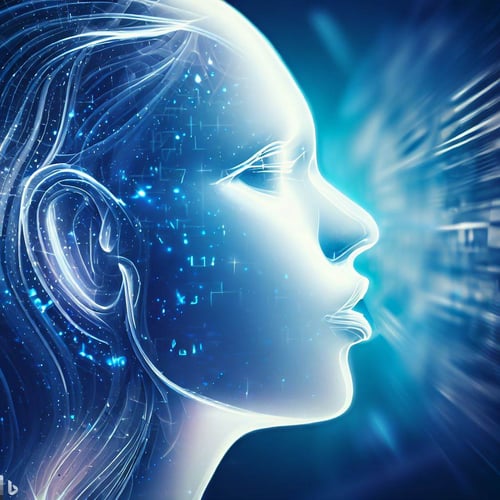AI-Generated Content Limitations: Impact on Marketing Success
- Home
- AI-Generated Content Limitations: Impact on Marketing Success
AI-generated content limitations are increasingly becoming a focal point for marketers as artificial intelligence (AI) continues to shape the landscape of content creation. LLMs such as GPT-3 have made it feasible to create a great deal of extended content with limited human involvement, revolutionizing the way text is generated. However, these AI tools still have major shortcomings that need addressing.

In this blog post, we will delve into the intricacies of natural language processing and machine learning technologies behind LLMs while shedding light on their inherent limitations. We will discuss how emotion-based chatbots often lack vulnerability and struggle to generate new ideas from scratch.
Furthermore, we'll explore popular plugin solutions aimed at enhancing AI-generated content and identify areas where human writers continue to excel over machines. By examining strategies for staying ahead in an AI-dominated world, you'll learn how leveraging LLMs for idea generation and research can be combined with a focus on personalization, emotion, and audience engagement to overcome AI-generated content limitations effectively.
Table of Contents:
- AI-Generated Content: The New Normal
- Exploring the Rise of AI-Generated Content
- Understanding How LLMs Work
- Limitations of Large Language Models
- Lack of Vulnerability in Emotion-Based Chatbots
- Difficulty Generating New Ideas from Scratch
- Overcoming ChatGPT Limitations Through Plugins
- Analyzing Popular Plugin Solutions for Improving AI-Generated Content
- Identifying Areas Where Humans Continue To Excel Over Machines
- Advantages Human Creators Still Hold
- Emotional Connection Through Personal Storytelling
- Adaptability Based on Audience Feedback
- Strategies for Staying Ahead in an AI-Dominated World
- Leveraging LLMs for Idea Generation and Research
- Focusing on Personalization, Emotion, and Audience Engagement
- Conclusion
AI-Generated Content: The New Normal
As the digital landscape continues to evolve, AI-generated content is becoming increasingly prevalent. Large language models (LLMs) like ChatGPT4 and Google Bard are producing outputs that often surpass human-created works in terms of quality and efficiency. With AI tools capable of generating vast quantities of content at an unprecedented pace, it's essential for creators to understand LLMs' limitations in order to maintain their competitive edge.
Exploring the Rise of AI-Generated Content

The development of advanced artificial intelligence technologies has revolutionized the way we approach content creation. Thanks to breakthroughs in natural language processing and machine learning, modern AI systems can generate text that closely mimics human behaviour. AI-generated content has become increasingly sought after, from blog posts to social media updates.
In recent years, major players such as OpenAI have introduced large language models capable of creating long-form content with remarkable accuracy. These powerful algorithms analyze vast amounts of data from search results and other sources before generating coherent pieces tailored towards specific audiences or topics.
Understanding How LLMs Work
To stay ahead in this rapidly changing environment, it's crucial for creators not only to recognize but also comprehend how these large language models function. By understanding their inner workings - including strengths as well as weaknesses - you'll be better equipped when competing against them within your niche market segment(s).
- Natural Language Processing: At its core lies sophisticated NLP techniques enabling machines effectively process linguistic information while making sense of complex sentence structures like those found among human speech patterns.
- Machine Learning: LLMs employ advanced machine learning algorithms to analyze and learn from vast quantities of text data, allowing them to generate content that closely resembles human-produced material.
- Data-Driven Approach: By examining millions or even billions of search results, AI-generated content tools can identify trends and preferences within specific niches, helping them produce valuable content tailored to their target audience(s).
Despite the potential of AI-generated content, there are still substantial restrictions that cannot be overlooked. In the following sections, we'll delve deeper into some key areas where humans continue to excel over machines - providing insights on how you can leverage your unique strengths as a creator in an increasingly AI-dominated world.
AI-generated content is now commonplace, yet it's essential to comprehend its restrictions. With this in mind, let us explore the challenges of using large language models for AI-generated content.
Key Takeaway: As the digital landscape evolves, AI-generated content becomes more prevalent. To maintain a competitive edge in this rapidly changing environment it's important to understand both the strengths and limitations of large language models (LLMs) like ChatGPT4 and Google Bard. By delving into how these powerful algorithms work, creators can identify areas where they have an advantage over machines - allowing them to stay ahead of the game.
Limitations of Large Language Models

Despite their impressive capabilities, LLM AIs have specific shortcomings that prevent them from matching or exceeding certain aspects of human creativity. By identifying these limitations, creators can develop strategies to stay ahead in the world of digital content production.
Lack of Vulnerability in Emotion-Based Chatbots
One major limitation faced by emotion-based chatbots, such as those powered by natural language processing and machine learning technologies, is their inability to exhibit vulnerability. Human writers have the capacity to make content that stirs up feelings among readers since they can impart individual encounters and communicate real emotions. In contrast, AI-generated content often lacks this depth and authenticity due to its reliance on vast quantities of data rather than actual human experience.
Difficulty Generating New Ideas from Scratch
Another challenge for AI tools like large language models is generating new ideas from scratch. While they excel at producing long-form content based on existing information, they struggle when it comes to developing truly original concepts. For example, a blog post generated by an AI might be able to provide valuable insights into a topic but may fail to present groundbreaking perspectives or innovative solutions not already found within search results.
This issue stems from the fact that artificial intelligence relies heavily on pattern recognition and analysis derived from pre-existing data sources - making it difficult for machines to think "outside the box" like humans do when creating content.
Tips for Overcoming AI Limitations:
- Foster Emotional Connections: Focus on incorporating personal anecdotes and emotions into your writing to create a more authentic connection with readers.
- Think Creatively: Challenge yourself to explore new ideas, perspectives, and solutions that haven't been covered extensively in existing content. This will help you stand out from AI-generated pieces that tend to rehash the same information.
- Leverage Human Expertise: Collaborate with experts in your field or industry who can provide unique insights and knowledge not readily available through machine learning algorithms.
In order for human creators to maintain their competitive edge over AI-generated content, it's essential they understand these limitations of large language models. By focusing on areas where machines fall short - such as vulnerability and original idea generation - writers can continue producing engaging, informative content that resonates with their target audience.
Large language models can suffer from high perplexity and increased randomness, so it is essential to explore ways of addressing these issues. By analyzing popular plugin solutions for improving AI-generated content, we can identify areas where humans continue to excel over machines.
Key Takeaway: This article outlines the limitations of large language models and AI-generated content, such as their lack of vulnerability in emotion-based chatbots and difficulty generating new ideas from scratch. To stay ahead in digital content production, human creators should recognize these shortcomings and focus on fostering emotional connections, thinking creatively, and leveraging expert knowledge to produce original work that resonates with readers.
Overcoming ChatGPT Limitations Through Plugins
In the rapidly evolving world of AI-generated content, developers are constantly working on innovative solutions to overcome the limitations of large language models like ChatGPT. One such approach is through the use of plugins, which aim to enhance AI capabilities and improve overall content quality. However, even with these advancements, there are still areas where human writers excel over machines.
Analyzing Popular Plugin Solutions for Improving AI-Generated Content
Several plugins have emerged in recent years that promise to address some common issues associated with LLM AIs like ChatGPT. Some popular options include:
- OpenAI's API: This powerful tool allows users to access advanced natural language processing features from OpenAI's extensive library, enabling them to fine-tune their AI-generated text according to specific requirements.
- GPT-3 Creative Writing Assistant: Designed specifically for creative writing tasks, this plugin offers a user-friendly interface that simplifies interaction with GPT-3 technology while providing additional customization options.
- Copy.ai: As an all-in-one platform for generating various types of content using machine learning algorithms, Copy.ai helps businesses automate their content creation process by offering tools tailored towards different industries and purposes.
Identifying Areas Where Humans Continue To Excel Over Machines
While these emerging plugins can certainly help ameliorate some limitations inherent within LLM AIs like ChatGPT; they still struggle when it comes to certain aspects of content creation that human writers excel at. Some key areas where humans continue to outperform AI-generated content include:
- Vulnerability: Human writers can effectively convey vulnerability and emotion in their writing, which is a crucial element for establishing an emotional connection with the audience.
- Idea Generation: Although LLM AIs like ChatGPT can generate vast quantities of text based on given prompts, they often lack the ability to create entirely new ideas from scratch or develop unique perspectives on existing topics.
- Target Audience Catering: Human creators possess a deep understanding of human behaviour and are better equipped to tailor their content specifically towards different target audiences, ensuring greater engagement and relevance in search results.
In order to stay ahead in this competitive landscape dominated by artificial intelligence tools, it's essential for human creators not only to embrace these technological advancements but also focus on honing their skills within those specific domains wherein flesh-and-blood authors still hold sway over machines.
By leveraging popular plugin solutions, companies can reduce the limitations of AI-generated content and produce more accurate results. Additionally, human creators still hold an advantage in terms of creating emotionally engaging stories that are tailored to their audience's needs; this is a key area where machines cannot yet compete with humans.
Key Takeaway: This article highlights the limitations of AI-generated content and examines popular plugin solutions for improving it. Despite these advancements, human writers still excel in areas such as conveying emotion and vulnerability, generating new ideas from scratch or catering to specific target audiences - making them a cut above machines.
Advantages Human Creators Still Hold
While artificial intelligence continues its rapid development trajectory within the realm of creative writing and beyond, there remain several key advantages exclusive only among flesh-and-blood authors who are capable enough of delivering unique experiences tailored specifically toward each individual reader group or demographic involved as well. In this section, we will explore some of these crucial strengths that human creators still possess in comparison to AI-generated content.
Emotional Connection Through Personal Storytelling
One major limitation of AI-generated content is its inability to convey vulnerability and forge genuine emotional connections with readers. While AI tools can produce vast quantities of text based on natural language processing algorithms, they lack the innate understanding of human emotions required for truly impactful storytelling. Humans have the capacity to utilize their own life experiences and recognize the emotions of those they are writing for, allowing them to create material that resonates on a much deeper level.
Adaptability Based on Audience Feedback
In addition to emotional depth, another area where humans excel over machines is adaptability. As machine learning models, like those used for generating AI content, rely heavily on pre-existing data sets; they may struggle when faced with new information or evolving trends. On the other hand, human writers have an inherent ability to learn from the feedback provided by their audiences - whether it be through comments sections under blog posts or social media interactions - allowing them not only to adjust but also to improve future pieces accordingly so as better cater towards readers' preferences overall.
- Emotional connection: Human writers can create content that resonates with their audience on an emotional level, something AI-generated content often struggles to achieve.
- Adaptability: Unlike AI tools, human creators have the ability to learn from feedback and adjust their writing style accordingly in order to better cater towards reader preferences over time.
In light of these advantages, it becomes clear that while AI-generated content may offer efficiency and scalability benefits for certain tasks within the realm of digital marketing; there will always remain a need - at least until further advancements are made - for skilled human authors who possess unique insights into both themselves as well individual members comprising each target demographic they aim to serve ultimately.
Humans are still able to create content that resonates with their audience on an emotional level, making them invaluable for creating engaging and personalized experiences. Businesses must use the correct techniques and plans to remain ahead in this AI-driven world.
Key Takeaway: This article highlights the unique advantages that human writers still possess over AI-generated content, such as their ability to create emotional connections with readers and adapt based on audience feedback. Despite its efficiency benefits, it's clear that skilled authors remain essential for providing tailor-made experiences to different target demographics - a job for which machines can't do justice just yet.
Strategies for Staying Ahead in an AI-Dominated World
 To ensure relevance amidst increasing competition from advanced language models, it's crucial that writers adapt by honing their skills while embracing technological advancements. This section will provide practical tips on how to maintain a competitive edge and create content that stands out in the AI-dominated landscape.
To ensure relevance amidst increasing competition from advanced language models, it's crucial that writers adapt by honing their skills while embracing technological advancements. This section will provide practical tips on how to maintain a competitive edge and create content that stands out in the AI-dominated landscape.
Leveraging LLMs for Idea Generation and Research
Rather than seeing AI as an adversary, consider it a tool to help you stay ahead. Large language models can be invaluable resources when generating ideas or conducting research. By utilizing AI-generated material, you can quickly accumulate copious amounts of data on any given topic without having to exhaustively examine search results.
- Idea generation: Use tools like ChatGPT4 or Google Bard to generate text based on specific prompts, providing new angles or perspectives on your chosen subject matter.
- Research assistance: Utilize natural language processing and machine learning algorithms available through various platforms such as OpenAI's GPT-3 API, which can help identify relevant sources and extract key insights efficiently.
Focusing on Personalization, Emotion, and Audience Engagement
The major limitations of large language models lie in their inability to replicate human behaviour authentically. As a writer looking to stand out from the crowd, focus on creating content that resonates with your audience emotionally by incorporating personal stories and experiences into your work.
- Personalization: Customize your content to cater specifically to your target audience. If you're crafting content for an organisation such as Whitehat Inbound Marketing in the UK, ensure that your writing reflects their image and style.
- Emotion: While AI-generated content can be informative, it often lacks emotional depth. By sharing personal anecdotes or using emotive language in your writing, you'll forge a stronger connection with readers and create more valuable content.
- Audience engagement: Encourage interaction by posing questions within blog posts or inviting feedback on social media platforms. This not only fosters community but also provides insights into what resonates best with readers - information that AI tools cannot yet access effectively.
In an increasingly digital world dominated by artificial intelligence and machine learning algorithms, human writers must learn how to adapt and thrive alongside these technological advancements. By leveraging large language models for idea generation and research while focusing on personalization, emotion, and audience engagement in our own work; we can ensure our creative output remains relevant amidst the ever-growing tide of AI-generated content.
Key Takeaway: This article provides practical strategies for writers to stay ahead in an AI-dominated world. It suggests leveraging LLMs (Large Language Models) as a tool, personalizing content according to the target audience's needs, evoking emotion and encouraging engagement with readers. With these tips in mind, professionals can continue creating valuable content that stands out amongst the flood of AI-generated material.
Conclusion
As AI-generated content continues to become more commonplace, it is important for marketers and business owners to be aware of the limitations associated with large language models such as ChatGPT. By understanding these constraints and taking advantage of plugins that can help overcome them, businesses will stay ahead in an increasingly competitive world dominated by artificial intelligence. It is also essential to remember that human creators still hold certain advantages over machines when it comes to creating unique, high-quality content; therefore leveraging a combination of both AI and manual efforts may provide the best results when striving for success in this new digital landscape.
Unlock the potential of AI-generated content and maximize its impact on your inbound marketing strategy by working with an experienced team to identify limitations and create effective solutions. Take control of your success today!


